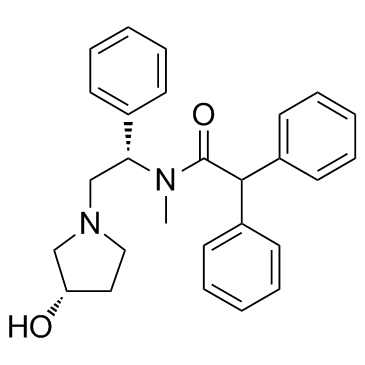| Description |
Asimadoline is a potent κ opioid receptor agonist with IC50s of 5.6 and 1.2 nM for guinea pig and human recombinant κ opioid receptor, respectively.
|
| Related Catalog |
|
| Target |
IC50: 5.6 nM (guinea pig κ opioid), 1.2 nM (human recombinant κ opioid)[1]
|
| In Vitro |
The IC50 for Asimadoline binding to μ-opioid receptors is 3 µM and to δ-opioid receptors is 0.7 µM. The IC50 values for D1, D2, kainate, σ, PCP/NMDA, H1, α1, α2, M1/M2, glycine, 5HT1A, 5HT1C, 5HT1D, 5HT2, 5HT3, AMPA and kainate/AMPA receptors are all >10 IC50, suggesting no relevant antihistaminergic, antiserotonergic or anticholinergic effects. At high concentrations, Asimadoline demonstrates spasmolytic action against 400 µM barium chloride in the rat duodenum (IC50=4.2 µM), suggesting that Asimadoline may block the direct stimulant effects of barium on smooth muscle through mechanisms that are not identified[1].
|
| In Vivo |
The absorption rate following oral administration is 80% in rats and >90% in dogs and monkeys. The metabolism of Asimadoline is rapid and appears similar in animals and man. Asimadoline has peripheral anti-inflammatory actions that are partly mediated through increase in joint fluid substance P levels[1]. Treatment with Asimadoline (5 mg/kg/day i.p.) produces marked (and sustained) attenuation of the disease with all three time regimes[2].
|
| Animal Admin |
Rats: Asimadoline (5 mg/kg/day, n=10 per group) or vehicle (2 mL/kg/day, n=10) is administered to DA rats by i.p. injection twice daily (i) during the primary inflammatory phase (days 1–3); (ii) once the disease is established (days 13–21); or (iii) throughout the entire time course (days 1-21). Non-arthritic control animals receive Asimadoline (5 mg/kg/day, n=5) or vehicle (2 mL/kg/day, n=5) by i.p. injection twice daily. In all cases, disease parameters are assessed. In this experiment, the SP content of joint tissue is assessed only after the rats are killed (day 21)[2].
|
| References |
[1]. Camilleri M, et al. Asimadoline, a κ-Opioid Agonist, and Visceral Sensation. Neurogastroenterol Motil. 2008 Sep; 20(9): 971–979. [2]. Binder W, et al. Involvement of substance P in the anti-inflammatory effects of the peripherally selective kappa-opioid asimadoline and the NK1 antagonist GR205171. Eur J Neurosci. 1999 Jun;11(6):2065-72.
|
